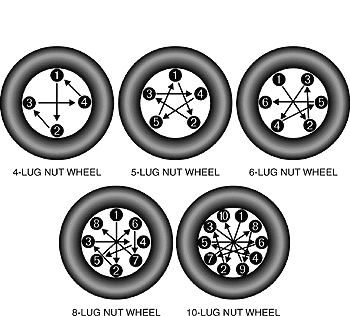How to Change a Flat Tire
Tools to have in your trunk for changing a flat..
1) Leverage Pipe (piece of metal pipe about 2 feet log)
2) Lug-nut Key (for Locking Lug Nuts Only)
3) Chock (wooden block)
4) Rag
5) Spare Tire (with Air In It)
6) Flashlight
7) Jack
8) Lug-nut Wrench
9) Screwdriver
10) Safety Triangles or Flares
1) Turn the flashers on and slowly and safely pull off the road. Find a spot that is visible but also away from traffic. Avoid soft shoulders and inclines. Put the hood up to indicate to other motorists that you are in mechanical distress, or set out some orange triangles. (you should have these in your trunk)
2) Apply the parking brake and put the transmission in park or in gear so the car won't roll.
3) Open the trunk and take out a spare tire, leverage pipe, jack, lug-nut wrench and (if it's dark out) flashlight . The leverage pipe is simply a piece of hollow pipe that can help you loosen a lug nut previously tightened with an air ratchet; you can buy this at a hardware or plumbing supply store.
4) Chock the other wheels with a board or a log to prevent the car from rolling.
5) Remove the hubcap with a screwdriver or tool that came with your vehicle. Many newer cars have hubcaps that don't require removal for access to the lug nuts.
6) Use the lug-nut wrench to loosen the lug nuts on the flat tire (but do not remove them). To loosen the nuts, turn counterclockwise. Remember: lefty-loosy, righty-tighty. If it doesn't come off easily, place the leverage pipe over the end of the lug-nut wrench and pull up rather than push down to avoid back injury. If one lug on each wheel looks different from the rest and the lug-nut wrench doesn't fit it, then you have locking o keyed lug nuts (to prevent wheel theft). Check the glove compartment for a special key that fits on this lug nut and makes removal with the lug-nut wrench possible. If you don't have the lug nut key you may have to call a tow truck for help.
7) When all the nuts are loose, jack up the car, making sure the jack is vertical and well planted on the hard surface of the road (do not jack up a car on sand or dirt). You'll find diagrams indicating where to place the jack either in the car owner's manual or on a sticker affixed to the jack. Most cars have a small slot near each tire for the jack. Jack up the car slightly higher than needed to remove the flat tire; the spare will be larger because it is full of air.
8) Remove the lug nuts. Put them in your pocket or someplace else where they won't get lost.
9) Take the flat tire off and put it in the trunk.
10) Put the spare on. If you are unsure which way the wheel goes on, look for the air-pressure valve - it always faces out.
11) Tighten the lug nuts by turning clockwise. Start them by and at first to avoid cross threading them. Use a crisscross or star pattern so the wheel doesn't go on cockeyed . See pattern to use below....

12) Lower the car and remove the jack.
13) Tighten the lug nuts again using the leverage pipe. Make them as tight as you can. Again use the chart above when tightening them.
14) Replace the hubcap (if applicable).
15) Put everything away neatly so it's ready for next time.
16) Remove the chock, then drive to a tire shop.
Its a good idea to go straight to the nearest shop and have them check it out to see if the lug nuts are tight enough and the tire you put on has enough air.
Most shops can fix flats while you wait, and it's usually inexpensive.

